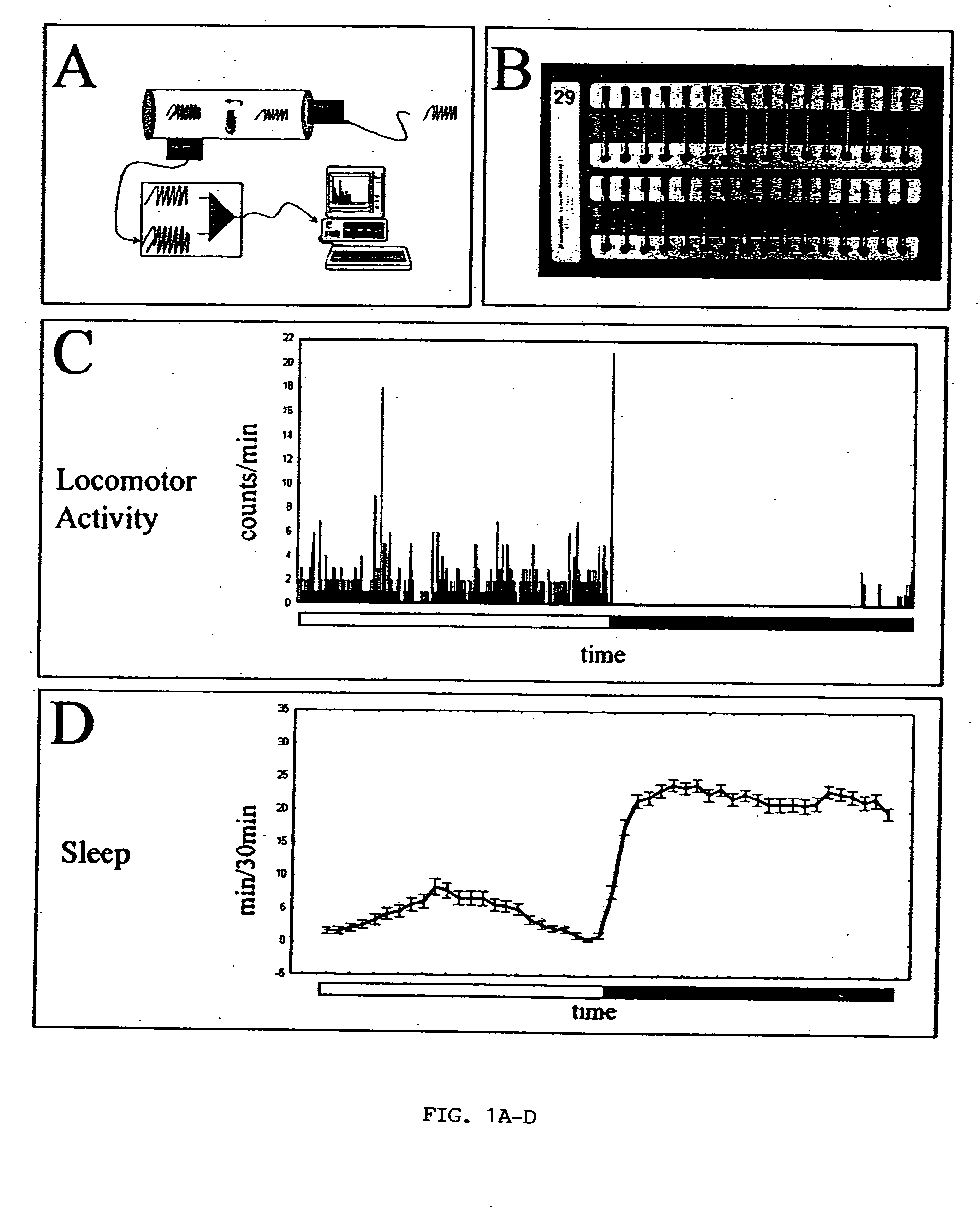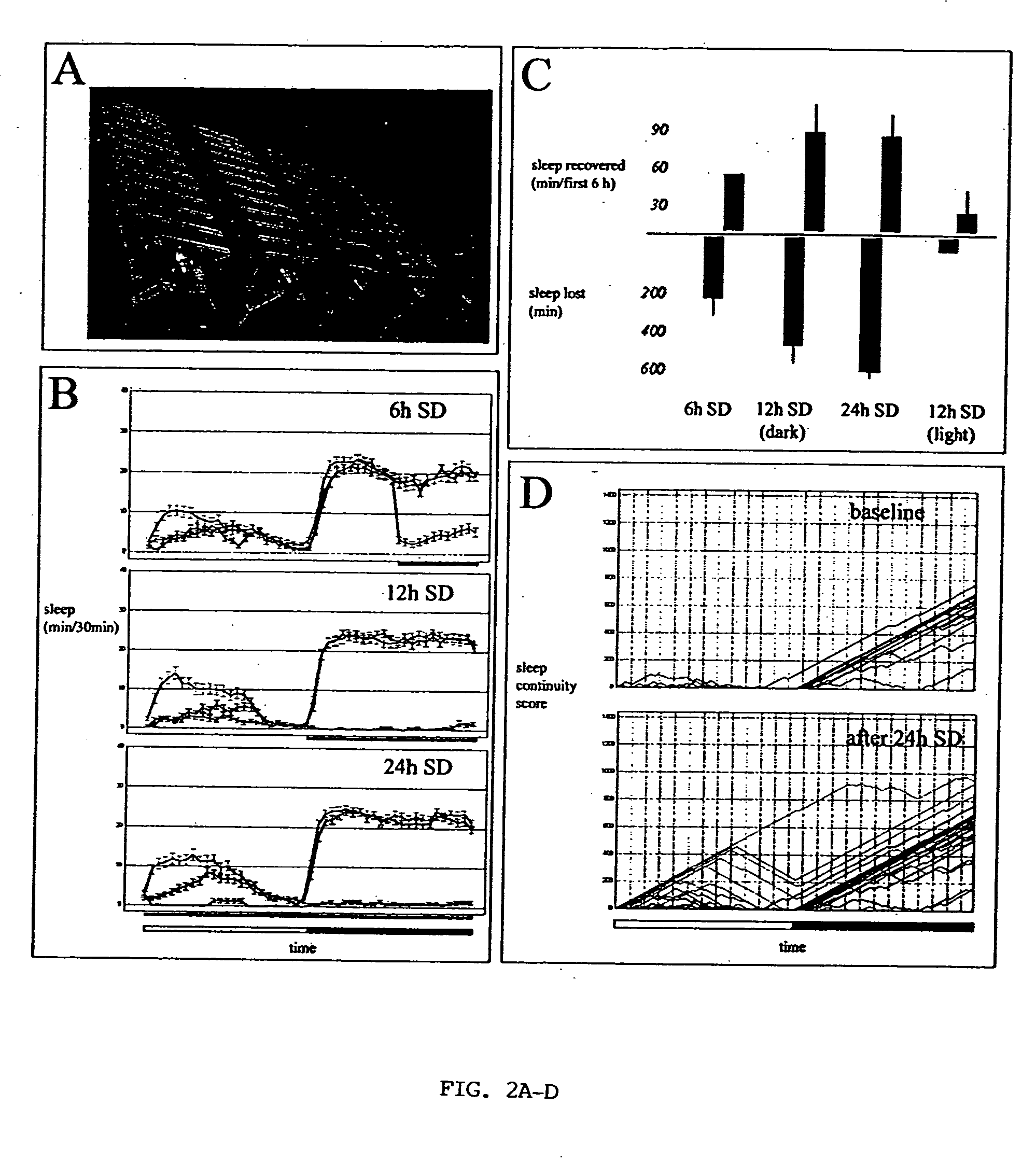Sleep genes in Drosophila and their use for the screening, diagnosis and therapy of sleep disorders
a technology of drosophila and genes for sleep disorders, applied in the field of molecular biology, cell biology, pharmacology, can solve the problems of reducing alertness, affecting sleep quality, and affecting sleep quality, so as to promote sleep, inhibit sleep, and promote sleep recovery
- Summary
- Abstract
- Description
- Claims
- Application Information
AI Technical Summary
Benefits of technology
Problems solved by technology
Method used
Image
Examples
example 1
and Methods
Analysis of Sleep in Drosophila.
[0323] The inventors monitored fly behavior using visual observation, an ultrasound activity monitoring system, and an automatic infrared system (Drosophila Activity Monitoring System, DAMS; Trikinetics, Waltham, Mass.). The ultrasound method (Shaw et al., 2000) allows a continuous, high-resolution measurement of the behavior of a single fly housed inside an ultrasound standing wave chamber (FIG. 1A). Whenever the fly moves its head, wings, or limbs, a perturbation of the standing wave is produced and is counted as a movement. Although very precise, this method is impractical for evaluating sleep / waking parameters in a large-scale project. The DAMS is instead designed to monitor hundreds or thousands of flies simultaneously. One DAMS monitor contains 32 glass tubes, each housing a single fly and enough food for 1-week recording (FIG. 1B). As each fly moves back and forth in its tube, it interrupts an infrared light beam that bisects the t...
example 2
[0328] The demonstration that Drosophila sleeps has advanced the knowledge of the phylogeny of sleep, supporting the notion that sleep fulfills at least one fundamental function in many divergent animal species. However, Drosophila can also benefit sleep research by offering a powerful tool for the genetic dissection of sleep, just as it has benefited research on circadian rhythms. The inventors have embarked on a large-scale mutagenesis screening in search for flies that need little sleep and / or do not show a sleep rebound after sleep deprivation. The final goal is to screen as many mutant fly lines as there are fly genes. Over the last 3 years, ˜9000 mutant lines have been screened, many of them carrying a mutation in a single gene (Cirelli, 2003). The mutation was caused either by the insertion of a transposon in the fly genome (insertional mutagenesis; ˜3000 lines screened so far), or by ethyl methanesulfonate (EMS, chemical mutagenesis; ˜6000 lines screened so far). Insertional...
PUM
| Property | Measurement | Unit |
|---|---|---|
| time course | aaaaa | aaaaa |
| time | aaaaa | aaaaa |
| frequency | aaaaa | aaaaa |
Abstract
Description
Claims
Application Information
 Login to View More
Login to View More - R&D
- Intellectual Property
- Life Sciences
- Materials
- Tech Scout
- Unparalleled Data Quality
- Higher Quality Content
- 60% Fewer Hallucinations
Browse by: Latest US Patents, China's latest patents, Technical Efficacy Thesaurus, Application Domain, Technology Topic, Popular Technical Reports.
© 2025 PatSnap. All rights reserved.Legal|Privacy policy|Modern Slavery Act Transparency Statement|Sitemap|About US| Contact US: help@patsnap.com



